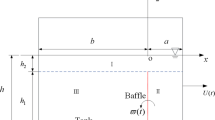Abstract
Sloshing makes it challenging to transport liquid-containing systems fast. Accurate prediction and effective suppression of sloshing are essential in many industrial applications. Two different methods are commonly used to numerically investigate the sloshing phenomenon: CFD simulation and equivalent mechanical model. Due to each method’s pros and cons, the solutions based on potential flow theory can be a good alternative for sloshing study. However, previous studies mostly focused on sloshing under sinusoidal oscillations, and only a little effort has been made to understand and suppress the sloshing under point-to-point movements. In this study, potential solutions for sloshing in a rectangular tank under horizontal point-to-point movements are newly derived and verified by comparing with the present CFD results. So far, the velocity profile of liquid-containing tanks has attracted little attention from the sloshing suppression point of view. However, simply a suitable choice of velocity profile (acceleration/deceleration duration) can lead to much-reduced sloshing. Results show that the present potential solutions are beneficial for designing the tank velocity profile for minimum residual sloshing under a given condition. It is also shown that the acceleration/deceleration duration affects the sloshing amplitude more significantly than its magnitude.
Similar content being viewed by others
Abbreviations
- a T :
-
Tank acceleration
- C n :
-
Modal contribution coefficient
- h :
-
Initial water height
- L :
-
Tank length
- T a :
-
Acceleration duration
- T d :
-
Deceleration duration
- T max :
-
Maximum travelling time allowed
- T n :
-
n -th mode period of natural sloshing
- U max :
-
Maximum velocity
- μ T :
-
Tank velocity
- α :
-
Scalar function for VOF model
- ϕ:
-
Total potential for fluid flow
- ϕ tank :
-
Potential for tank motion
- ϕ :
-
Potential for fluid motion relative to tank
- η left :
-
Perturbed elevation at the left wall
- η’ left :
-
Difference between maximum and minimum water elevations at the left wall
- ω n :
-
Angular frequency of natural sloshing
References
R. A. Ibrahim, Liquid Sloshing Dynamics: Theory and Applications, Cambridge University Press, Cambridge, United Kingdom (2005).
O. M. Faltinsen and A. N. Timokha, Sloshing, Cambridge University Press, New York, USA (2009).
S. Rebouillat and D. Liksonov, Fluid-structure interaction in partially filled liquid containers: a comparative review of numerical approaches, Computers and Fluids, 39(5) (2010) 739–746.
D. Liu and P. Lin, A numerical study of three-dimensional liquid sloshing in tanks, J. of Computational Physics, 227(8) (2008) 3921–3939.
D. Liu and P. Lin, Three-dimensional liquid sloshing in a tank with baffles, Ocean Engineering, 36(2) (2009) 202–212.
A. Aboel-Hassan, M. Arafa and A. Nassef, Design and optimization of input shapers for liquid slosh suppression, J. of Sound and Vibration, 320(1–2) (2009) 1–15.
K. Yano and K. Terashima, Robust liquid container transfer control for complete sloshing suppression, IEEE Transactions on Control Systems Technology, 9(3) (2001) 483–493.
G. X. Wu, Q. W. Ma and R. E. Taylor, Numerical simulation of sloshing waves in a 3D tank based on a finite element method, Applied Ocean Research, 20(6) (1998) 337–355.
B.-F. Chen and R. Nokes, Time-independent finite difference analysis of fully non-linear and viscous fluid sloshing in a rectangular tank, J. of Computational Physics, 209(1) (2005) 47–81.
H. Akyildiz and N. E. Unal, Sloshing in a three-dimensional rectangular tank: numerical simulation and experimental validation, Ocean Engineering, 33(6) (2006) 2135–2149.
C. W. Hirt and B. D. Nichols, Volume of fluid (VOF) method for the dynamics of free boundaries, J. of Computational Physics, 39(1) (1981) 201–225.
Acknowledgments
This research was supported by Kumoh National Institute of Technology.
Author information
Authors and Affiliations
Corresponding author
Additional information
Dongjoo Kim is a Professor of Mechanical Engineering at Kumoh National Institute of Technology. He received his Ph.D. in Mechanical Engineering from Seoul National University. His research interests include computational fluid dynamics, flow control, multiphase flow, and particle dynamics.
Rights and permissions
About this article
Cite this article
Kim, D. Potential solution for sloshing in a horizontally moving rectangular tank and design of tank velocity profile. J Mech Sci Technol 35, 2981–2988 (2021). https://doi.org/10.1007/s12206-021-0621-1
Received:
Revised:
Accepted:
Published:
Issue Date:
DOI: https://doi.org/10.1007/s12206-021-0621-1




